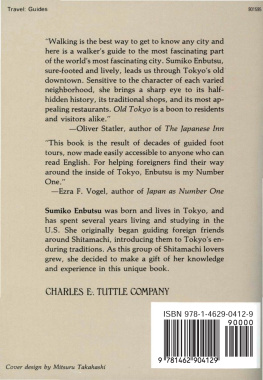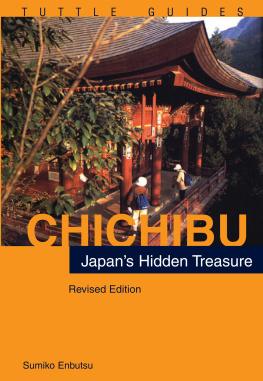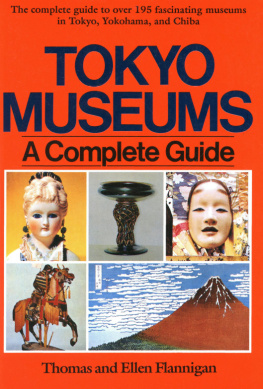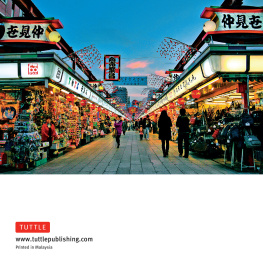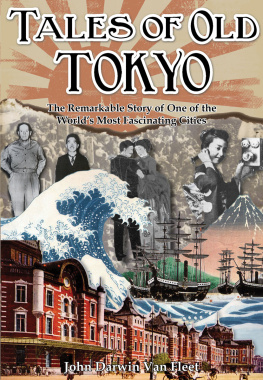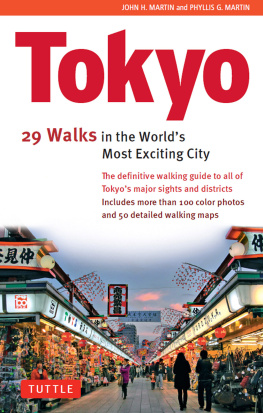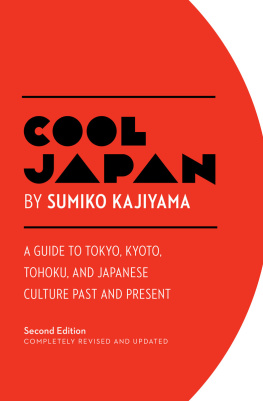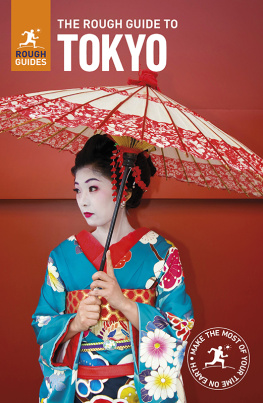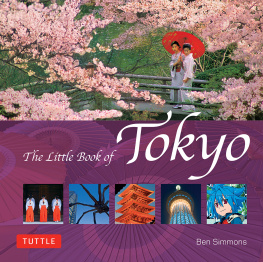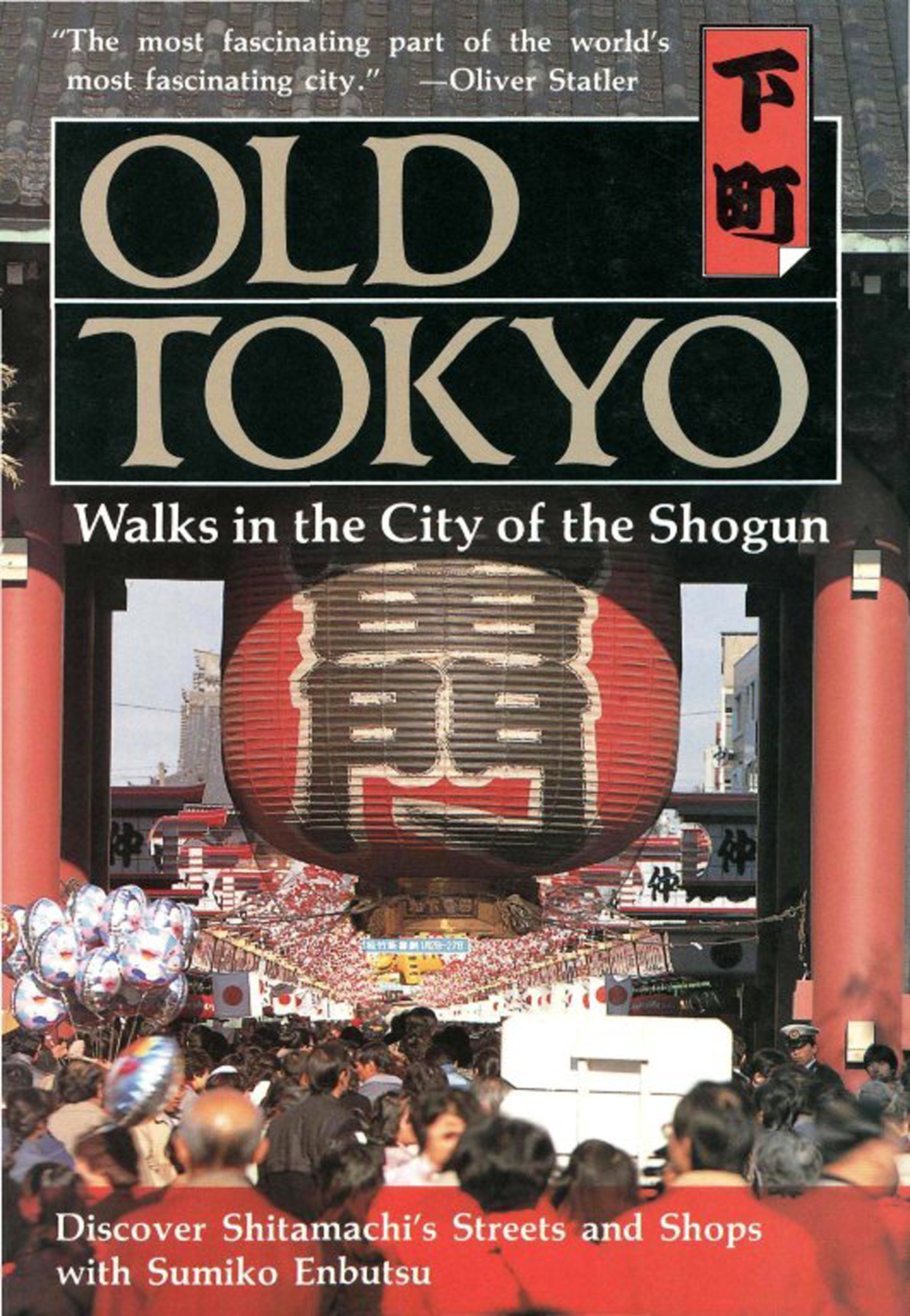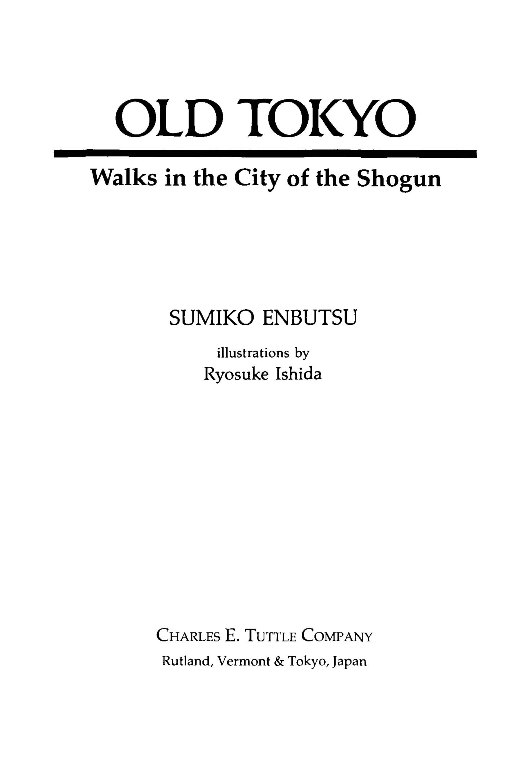Publisher
Published by Charles E. Tuttle Company, Inc.
of Rutland, Vermont & Tokyo, Japan
with editorial offices at
Osaki Shinagawa-ku, Tokyo 141-0032
1993 by Charles E. Tuttle Publishing Co., Inc.
All rights reserved
LCC Card No. 92-62458
ISBN: 978-1-4629-0412-9 (ebook)
First edition, 1993
Printed in Japan
C ONTENTS
Tokyo Overview
|
| 1 |
| 2 |
| 3 |
| 4 |
| 5 |
| 6 |
| 7 |
| 8 |
| 9 |
| 10 |
| 11 |
APPENDIXES: |
A CKNOWLEDGMENTS
The original version of this book, Discover Shitamachi, was published in 1984 as the result of suggestions and assistance from my friends who regretted the lack of a useful walking guide to Tokyo. Many friends eagerly participated in testing my manuscript on the field, and some, in editing and proofreading the text. I am still indebted to those old friends whose cooperation was vital to the birth of the book. This book unfortunately went out of print in 1990.
In publishing this completely revised and updated version, I have once again relied upon the encouragement and support of many friends. I owe a special debt of gratitude to Mr. Ryosuke Ishida, a renowned paper-cut artist, whose atmospheric depictions of Shitamachi people and neighborhoods are used to introduce each area covered in the book. I also appreciate the permission of the ward offices of Chuo, Koto, Taito, Shinagawa, and Sumida wards to use some of the excellent photographs from their files. I also tender my heartfelt gratitude for the kind efforts of other individuals and organizations whose cooperation over the years has enabled the publication of this book. I express my deep gratitude and hope they will continue to be generous with their counsel and support in the future.
T OKYO OVERVIEW
Four hundred years ago, Tokyo was a vast stretch of wilderness. The sea reached deep inland, its water almost lapping at the base of the Imperial Palace. The Ginza and Tsukiji were under water, and Tokyo Station was in the middle of a marsh. To this desolate land came Tokugawa Ieyasu, a far-sighted samurai lord, who built a town there in 1590. He named it Edo, meaning "waterfront." Soon after Ieyasu's rise to the national leadership, this burgeoning town became the capital of Japan. He relaid the city plan and adopted an unprecedented spiral design originating from his castle. To secure political stability, he institutionalized various systems to promote national unity under a central feudal administration. Foreign contact was restricted, and peace prevailed in the country for nearly three centuries.
There was one thing which Ieyasu did not quite foresee, however. The new peace and stability sapped the samurai's energy, and the commoners who profited most from peace gained in eminence. Edo became a stage for merchants and craftsmen to display their economic and cultural vitality. Many Japanese things which are internationally appreciated, such as Kabuki, ukiyo-e, sushi, and tempura, to name but a few, are the products of these commoners' creativity. They lived in a densely populated area called Shitamachi, literally "the land below" (the castle). Adjacent to what is now the high-tech business hub of Tokyo, Shitamachi still harbors the energy and spirit of the old Edo commoners.
The original geography of the waterfront area discouraged all except the resourceful Ieyasu, who was soon to become the first of the Tokugawa shoguns. The setting was that of a frontier. In the east the Sumida River, large and untamed, discharged into the sea inundating the surrounding area with frequent floods. Patches of raised ground were dotted here and there, and some distance upstream stood Asakusa Kannon, an old temple dating from the seventh century. Down in the bay, the coast made a deep recess, forming an inlet called Hibiya. From there, the land rose in low hills rolling to the north and west. On the top of one of these hills was the abandoned residence of a medieval lord, the memory of his tragic assassination lurking in the ruins. A smaller stream, called the Hira River, flowed from here into the bay.
This uncultivated place was offered to Ieyasu in exchange for his original fief in Mikawa, which was closer to Kyoto and thus more civilized. Clearly, it was a scheme by wily Toyotomi Hideyoshi, the ruler at the time, who wanted to keep Ieyasu away from Kyoto, which had been the political center of Japan since the ninth century. Ieyasu accepted the offer in spite of his retainers' fierce objections. He saw a great future in the floodplain open to the sea. He also had confidence in the expertise of his civil-engineering staff. Thus, on August 1,1590, he made his official entry into Edo and immediately set out to develop the lowland beneath the abandoned heights.
Ieyasu modeled his first city plan on Kyoto, which had been designed after Changan, the capital of Tang dynasty China. The ancient Chinese believed that a city plan had to satisfy certain geographic conditions based on the worship of the four gods of heaven. There should be a large river in the east for the Dragon God to live in. In the south there should be a lake or sea for the Phoenix to reside in. In the west a large road was to be guarded by the Tiger God; and in the north there should be a mountain where the God of Xuanwu, symbolized by a turtle entwined with snakes, could live. All told, the requirements provide for a sunny land sloping down to the sea, with a convenient water supply and easy routes to other areas.
To adapt this time-honored principle of city planning to Edo, Ieyasu had to turn the direction of his city plan about 100 degrees counterclockwise. This was an ingenious solution designed to dispel the worries of his vassals. Mt. Fuji, which is actually to the west of Edo, now came to the north, crowning the hilltop site of the abandoned mansion where Ieyasu was going to build his castle. The Hira River ran to the east of the castle; in the south spread Edo Bay; and in the west the Tokaido Highway, though not yet fully developed, led to Kamakura and Kyoto. It was also decided to protect the northeast direction of the city by building a major temple there, just as Kyoto had Enryaku-ji in its northeastern suburb. The northeast was considered an unlucky direction, vulnerable to invasion by evil spirits and enemies, needing a powerful magic to ward them off.
Hideyoshi died in the course of the project, in 1598. A crucial battle ensued between two camps of warring lords, one supporting Ieyasu, and the other siding with Hideyori, Hideyoshi's young heir. Ieyasu won a decisive victory and the national leadership as a result. As shogun, in 1603, he proclaimed Edo the new capital of Japan, replacing Kyoto. This decision required that the city be reorganized, and so Ieyasu canceled the plan to build a quasi-Kyoto and adopted a bold spiral design instead.
The uncoiling line of a spiral spreads indefinitely and therefore would facilitate the city's expansion. A spiraling waterway was built by connecting rivers, ponds, and already cut canals, starting at the castle and unfolding clockwise to reach the Sumida River. The water-filled channels served the dual purpose of providing easy access to the city center from the sea and blocking the advance of potential invaders. Edo Castle was magnificently redesigned to demonstrate the shogun's status. The highest tower ever built in Japan was constructed, surrounded by layers of massive stone walls; at its base, a complex maze of buildings was erected. It was an enormous project which required the work of three generations of shogun before its full completion in 1640. To implement the new city plan, it became necessary to fill the inlet of Hibiya. Part of a hill near Kanda was excavated to provide soil for the reclamation. The resultant land became what is now Nihombashi, the Ginza, and Shimbashi.

